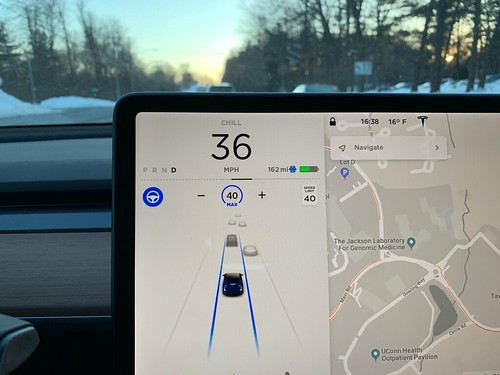
The singer Bing Crosby revolutionised recording technology because he was exhausted from making so many shows. Silicon Valley was the winner. CC-licensed photo by Ryan on Flickr.
You can sign up to receive each day’s Start Up post by email. You’ll need to click a confirmation link, so no spam.
It’s the last post of the year! Happy Christmas and New Year! Thanks for all the support and feedback and links. Back on Monday January 8.
A selection of 9 links for you. Read at your leisure. I’m @charlesarthur on Twitter. On Threads: charles_arthur. On Mastodon: https://newsie.social/@charlesarthur. Observations and links welcome.
The year the Millennials aged out of the internet • The New York Times
Max Read, in an opinion piece:
»
Something is changing about the internet, and I am not the only person to have noticed. Everywhere I turned online this year, someone was mourning: Amazon is “making itself worse” (as New York magazine moaned); Google Search is a “bloated and overmonetized” tragedy (as The Atlantic lamented); “social media is doomed to die,” (as the tech news website The Verge proclaimed); even TikTok is becoming “enjunkified” (to bowdlerize an inventive coinage of the sci-fi writer Cory Doctorow, republished in Wired). But the main complaint I have heard is was put best, and most bluntly, in The New Yorker: “The Internet Isn’t Fun Anymore.”
It’s indisputable that we are living through a transitional period in the short history of the internet. The end of the low interest-rate era has shaken up the economics of startups, ending rapid-growth practices like “blitzscaling” and reducing the number of new internet businesses vying for our attention; companies like Alphabet and Facebook are now mature and dominant businesses instead of disruptive upstarts. But I suspect there is another factor driving the alienation and discomfort felt by many of the people who feel as though the internet is dying before our eyes: We’re getting old.
For more than a decade now, millennials like myself have effectively (and, in the case of our cohort’s richest member, Mark Zuckerberg, quite literally) run the internet. We were the earliest adopters of smartphones and we once consistently (not that I’d brag about it) led the generational pack in screen time. Over that period we’ve grown used to an internet whose form and culture was significantly shaped by and molded to our preferences. The American internet of the 2010s was an often stupid and almost always embarrassing internet — but it was a millennial internet. There were no social networks on which we felt uncomfortable; no culture developments we didn’t engender; no image macros we didn’t understand.
This now seems to be changing. There was a time in my life when it was trivial to sign up to a new social network and pick up its patterns and mores on the fly. Now, I feel exhausted by the prospect.
…We’ve been used to wielding an innate understanding of the web’s capabilities and culture to our advantage; our knowledge of “how to search Google” and “how to use emoji” and “how to deploy the ‘Sarcastic Wonka’ meme,” which may once have given us an edge in multigenerational workplaces and social settings, is simply irrelevant to people younger than us.
«
Happy Christmas! And new year!
unique link to this extract
Lapsus$: GTA 6 hacker handed indefinite hospital order • BBC News
Joe Tidy:
»
An 18-year-old hacker who leaked clips of a forthcoming Grand Theft Auto (GTA) game has been sentenced to an indefinite hospital order.
Arion Kurtaj from Oxford, who is autistic, was a key member of international gang Lapsus$. The gang’s attacks on tech giants including Uber, Nvidia and Rockstar Games cost the firms nearly $10m.
The judge said Kurtaj’s skills and desire to commit cyber-crime meant he remained a high risk to the public. He will remain at a secure hospital for life unless doctors deem him no longer a danger.
The court heard that Kurtaj had been violent while in custody with dozens of reports of injury or property damage. Doctors deemed Kurtaj unfit to stand trial due to his acute autism so the jury was asked to determine whether or not he committed the alleged acts – not if he did so with criminal intent.
A mental health assessment used as part of the sentencing hearing said he “continued to express the intent to return to cyber-crime as soon as possible. He is highly motivated.”
The jury was told that while he was on bail for hacking Nvidia and BT/EE and in police protection at a Travelodge hotel, he continued hacking and carried out his most infamous hack.
Despite having his laptop confiscated, Kurtaj managed to breach Rockstar, the company behind GTA, using an Amazon Fire stick, his hotel TV and a mobile phone.
Kurtaj stole 90 clips of the unreleased and hugely anticipated Grand Theft Auto 6.
He broke into the company’s internal Slack messaging system to declare “if Rockstar does not contact me on Telegram within 24 hours I will start releasing the source code”.
«
Surely this guy will get a visit in the next few weeks from a recruiter at GCHQ. Not that we’ll ever find out. That’s the most amazing bit of improvisatory hacking I’ve ever heard of.
unique link to this extract
How pro-Russian ‘yacht’ propaganda influenced US debate over Ukraine aid – BBC News
Olga Robinson, Shayan Sardarizadeh and Mike Wendling:
»
A website founded by a former US Marine who now lives in Russia has fuelled a rumour that Volodymyr Zelensky purchased two luxury yachts with American aid money.
Despite the false claim, the disinformation plot was successful. It took off online and was echoed by members of the US Congress making crucial decisions about military spending.
It was an incredible assertion – using two advisers as proxies, Mr Zelensky paid $75m (£59m) for two yachts.
But not only has the Ukrainian government flatly denied the story, the two ships in question have not even been sold. Despite being false, the story reached members of the US Congress, where leaders say any decision on further aid to Ukraine will be delayed until next year.
…The story first emerged in late November on an obscure YouTube channel – one with only a handful of followers and just a single video in its feed.
The next day, it was picked up by a site called DC Weekly, alongside pictures of the two yachts – called Lucky Me and My Legacy – and documents purportedly confirming the sale of the boats to Zelensky’s associates.
But the luxury yacht brokers where both vessels are listed for sale said that the allegations are false. The sales documents appear to be forgeries. And instead of having been purchased by Zelensky or his close advisers, both Lucky Me and My Legacy are still up for sale.
The DC Weekly story touched off a blaze of online speculation, with multiple sources linking to the story and content citing the story across multiple platforms.
However, the site is not, as the name implies, a weekly publication – nor is it based in the US capital.
Research by Darren Linvill and Patrick Warren, disinformation researchers at Clemson University, shows that DC Weekly was started by John Mark Dougan, a former US Marine and Florida police officer who moved to Russia in 2016.Mr Dougan spent three years as a deputy with the Palm Beach County Sheriff’s office. After he left in 2009 he started a website spreading rumours about his former employers.
«
America elects idiots as legislators, part 945. (Plenty of examples available in the UK too.)
unique link to this extract
Warner Bros Discovery and Paramount CEOs hold exploratory merger talks • FT
Anna Nicolaou, James Fontanella-Khan and Christopher Grimes :
»
Warner Bros Discovery and Paramount Global are in early talks to merge, in a media deal that would combine the owner of HBO and CNN with the studio behind the Mission Impossible films and CBS News.
Warner chief executive David Zaslav and Paramount chief Bob Bakish discussed a possible deal over lunch at Paramount’s offices in New York this week, according to three people familiar with the matter. The talks were at an early stage and a deal might not materialise, these people cautioned.
The conversation was more of an expression of interest by Zaslav than an offer, according to one of the people familiar with the meeting between the two executives. Billionaire Shari Redstone, who controls Paramount, has also held preliminary talks with Skydance, the production company behind Top Gun: Maverick, run by David Ellison.
The discussions with Warner Bros, first reported by Axios, come as US media groups are struggling to improve their profitability after waging a costly “streaming war” against Netflix. Big entertainment groups including Warner, Paramount and Disney have been on a cost-cutting mission as they try to shrink losses running into the billions of dollars from their video streaming services.
«
More fallout from Netflix’s win in the streaming wars. Who’s big enough to stand alone? Netflix, Amazon, Apple. Any others?
unique link to this extract
‘A mass exodus’: why so many LA restaurants are closing • SF Gate
Karen Palmer:
»
pandemic-era government assistance in the form of Paycheck Protection Program loans and the Restaurant Revitalization Fund ran out long ago, and commercial rents in Los Angeles remain staggeringly high.
Operators are also feeling a major squeeze due to rising food and labour costs. Industry vet Jeremy Adler, who is a partner in the Santa Monica Southeast Asian restaurant Cobi’s and is in construction on a new restaurant in Mar Vista, points to expensive liquor licenses and new California laws like Assembly Bill 1228 as challenges for owners. AB 1228 is intended to create a liveable wage by raising the minimum wage for fast food workers to $20 in April 2024.
“That law puts pressure on independent restaurants as well,” Adler says. “When the average profit margin at a restaurant is 5-7%, 1% really matters.”
“The economics of owning a restaurant are completely out of whack right now,” says seasoned chef Chris Feldmeier, who shuttered his Silver Lake Spanish restaurant Bar Moruno in November. “We used to try to keep our labour costs under 30%, but now they’re inching up closer to 40%. With cooks making $22 to $25 an hour, it’s just hard for a small, private restaurant.”
Ciccolella adds, “It’s impossible to get quality food at a fair price. I have to sell my lobster roll for $29 at the restaurant, but I can sell it for $20 at my new Little Anchor truck because it’s just me and I don’t have all the labour costs.”
Manzke and the others also note that the Hollywood strikes this year were a major blow to restaurants.
“We always had a lot of support from Netflix at Republique. There would be someone there from the company every night, and that just stopped overnight,” he says. “Los Angeles is so tied to the entertainment industry.”“We used to cater for all of the studios in Culver City, and that completely went away,” Ciccolella says. Adler, meanwhile, notes that event business in early December, usually a way for restaurants to balance out the slower weeks at the end of the month, was also severely mitigated by the strike.
«
So the TL;DR is: the places where Hollywood’s writers and actors did their side business suddenly found they didn’t have any writers or actors. Double whammy for all the wait staff looking for acting jobs by slipping their details to directors. Perhaps a few more streaming merger negotiations will help matters.
unique link to this extract
Tech billionaires need to stop trying to make the science fiction they grew up on real • Scientific American
Charlie Stross, who actually is a SF author:
»
We were warned about the ideology driving these wealthy entrepreneurs by Timnit Gebru, former technical co-lead of the ethical artificial intelligence team at Google and founder of the Distributed Artificial Intelligence Research Institute (DAIR), and Émile Torres, a philosopher specializing in existential threats to humanity. They named this ideology TESCREAL, which stands for “transhumanism, extropianism, singularitarianism, cosmism, rationalism, effective altruism and longtermism.” These are separate but overlapping beliefs in the circles associated with big tech in California.
…TESCREAL is also heavily contaminated with Christian theological reasoning, [John] Campbellian white supremacism, Randian ruthlessness, the eugenics that was pervasive in the genre until the 1980s and the imperialist subtext of colonizing the universe.
But there is a problem: SF authors such as myself are popular entertainers who work to amuse an audience that is trained on what to expect by previous generations of science-fiction authors. We are not trying to accurately predict possible futures but to earn a living: any foresight is strictly coincidental. We recycle the existing material—and the result is influenced heavily by the biases of earlier writers and readers. The genre operates a lot like a large language model that is trained using a body of text heavily contaminated by previous LLMs; it tends to emit material like that of its predecessors. Most SF is small-c conservative insofar as it reflects the history of the field rather than trying to break ground or question received wisdom.
Science fiction, therefore, does not develop in accordance with the scientific method. It develops by popular entertainers trying to attract a bigger audience by pandering to them. The audience today includes billionaires who read science fiction in their childhood and who appear unaware of the ideological underpinnings of their youthful entertainment: elitism, “scientific” racism, eugenics, fascism and a blithe belief today in technology as the solution to societal problems.
In 2021 a meme arose based on writer and game designer Alex Blechman’s tweet about this issue (which was later posted to Mastodon):
»
Sci-Fi Author: In my book I invented the Torment Nexus as a cautionary tale
Tech Company: At long last, we have created the Torment Nexus from classic sci-fi novel Don’t Create The Torment Nexus«
It’s a worryingly accurate summary of the situation in Silicon Valley right now: the billionaires behind the steering wheel have mistaken cautionary tales and entertainments for a road map, and we’re trapped in the passenger seat.
«
That idea of SF as an early self-feeding LLM (though aren’t all literary genres therefore that?) is novel.
unique link to this extract
Researchers fear the spoken ‘r’ is ready to roll away from the last bastion of rhoticity in England • Phys.org
»
How do you pronounce your “r”s towards the ends of words like Shearer, purr, nerd and pore? And what about those in car, bird and her?
Chances are that if you are English, you will likely soften it out so that it sounds more like an elongation of the vowel, rather than the kind of “r” you find in words such as red or right.
The evidence is, according to Lancaster University researchers, that “r”s are becoming a thing of the past in England—apart from in Blackburn, where the “r” is still very much rolling.
Traditionally, parts of Lancashire have very clearly articulated “r”s, similar to the stereotype of Cornwall and the West Country. The pronunciation of these “r”s towards the ends of words is called rhoticity.
In fact, historically, hundreds of years ago, people throughout England used to pronounce strong “r”s. But now, says the research paper, these strong “r”s are definitely dying out.
In Blackburn, young speakers do mostly say their “r”s, but they are, according to the research team, phonetically very weak and often difficult to perceive. And they pronounce them less frequently than older speakers.
According to lead researcher Dr. Danielle Turton, who worked with Dr. Robert Lennon on the research project, the “r” in the spelling for speakers from these areas means that it should be pronounced like an “r” at the beginning of a word, rather than just creating a longer vowel.
“Speakers from places like Blackburn usually differentiate between pairs of words such as ‘stellar’ and ‘stella’, whereas most of England would consider them to be the same,” says Dr. Turton.
“However, for the youngest speakers in Blackburn, these ‘r’s are very weak, which raises the question of whether future generations will even hear these weak ‘r’s at all and whether this distinction will eventually fade away. Accent change is often like a puddle: it dries up in most places and leaves remnants around the edges, hence why Cornwall and East Lancs behave similarly here today.”
«
Read more about rhoticity – you thought it was the thing they turned the chicken on, didn’t you? – in the full paper.
unique link to this extract
AI as Algorithmic Thatcherism • Dan McQuillan
dan mcquillan is, well, taking no prisoners:
»
Faced with social structures whose foundations have been eaten away by decades of privatisation and austerity, the political response is to pump money into ‘frontier AI’ while hyping it up as the most awe-inspiring technology since the Manhattan Project. The Prime Minister says he will “harness the incredible potential of AI to transform our hospitals and schools” while ignoring leaking roofs in the NHS and the literally collapsing ceilings in local schools. This focus on the immaterial fantasies of AI is a deliberate diversion. When large language models are touted as passing basic medical exams, it’s because they’ve absorbed answers from across the internet. They are incapable of the embodied understanding and common sense that underpin medicine, education or any other form of care.
One thing that these models definitely do, though, is transfer control to large corporations. The amount of computing power and data required is so incomprehensibly vast that very few companies in the world have the wherewithal to train them. To promote large language models anywhere is privatisation by the back door. The evidence so far suggests that this will be accompanied by extensive job losses, as employers take AI’s shoddy emulation of real tasks as an excuse to trim their workforce. The goal isn’t to “support” teachers and healthcare workers but to plug the gaps with AI instead of with the desperately needed staff and resources.
Real AI isn’t sci-fi but the precaritisation of jobs, the continued privatisation of everything and the erasure of actual social relations. AI is Thatcherism in computational form. Like Thatcher herself, real world AI boosts bureaucratic cruelty towards the most vulnerable. Case after case, from Australia to the Netherlands, has proven that unleashing machine learning in welfare systems amplifies injustice and the punishment of the poor. AI doesn’t provide insights as it’s just a giant statistical guessing game. What it does do is amplify thoughtlessness, a lack of care, and a distancing from actual consequences. The logics of ranking and superiority are buried deep in the make up of artificial intelligence; married to populist politics, it becomes another vector for deciding who is disposable.
«
How Bing Crosby made Silicon Valley possible • The Honest Broker [not Roger Pielke]
Ted Gioia:
»
Long before he became chief engineer for Bing Crosby Enterprises, Jack Mullin was a major in the US Army Signal Corp, who spent a lot of time listening to Nazi radio broadcasts during World War II. Unlike his colleagues, Mullin was puzzled by the classical music he heard coming out of Germany—it sounded like live performances by orchestras, but somehow he doubted that the Berlin Philharmonic was really giving a concert so late at night.
After the end of the war, he solved the mystery. The army sent him to Germany to document their electronics technology, and he discovered magnetic tape recorders. This device, known as the Magnetophon was even used by Hitler to pre-record speeches, which could later be broadcast on the radio as live announcements.
Mullin returned to California, after the war, with two of these tape recorders, and plenty of tape, along with instruction manuals and schematic drawings. His goal was to create his own tape recording equipment with American parts.
On May 16, 1946, Mullin gave a demonstration of German Magnetophons at the NBC Studio in San Francisco. The buzz it created soon led to the launch of Ampex.
…Ampex, launched in San Carlos, California in 1944 is the key connecting point between music storage and data storage. That tiny startup, according to Silicon Valley historians Peter Hammar and Bob Wilson, was involved directly or indirectly in the launch of “almost every computer magnetic and optical disc recording system, including hard drives, floppy discs, high-density recorders, and RFID devices.”
Crosby himself moved to Silicon Valley in 1963, buying a home in Hillsborough for $175,000. (The house was recently listed for $14m.) According to his son Nathaniel, Crosby and his wife Kathryn didn’t want to raise their children in Hollywood. A few months later, they moved to an even larger house on the other side of town.
By any measure, Bing Crosby’s life was an amazing success story. And he understood the financial upside enough to become a West Coast distributor for both Ampex and 3M magnetic tape. But if he had taken equity positions in Silicon Valley startups, instead of just financing them as a customer and distributor, he might have become the godfather of high tech—and the Crosby family would be on the Forbes billionaire list today.
«
Thanks for the link (well worth reading in full!) to Mark C, who points out “in light of the Apple Watch problems: how Bing Crosby enabled a whole US industry to rip off German tech, patent-free”.
unique link to this extract
| • Why do social networks drive us a little mad? • Why does angry content seem to dominate what we see? • How much of a role do algorithms play in affecting what we see and do online? • What can we do about it? • Did Facebook have any inkling of what was coming in Myanmar in 2016? Read Social Warming, my latest book, and find answers – and more. |
Errata, corrigenda and ai no corrida: none notified









